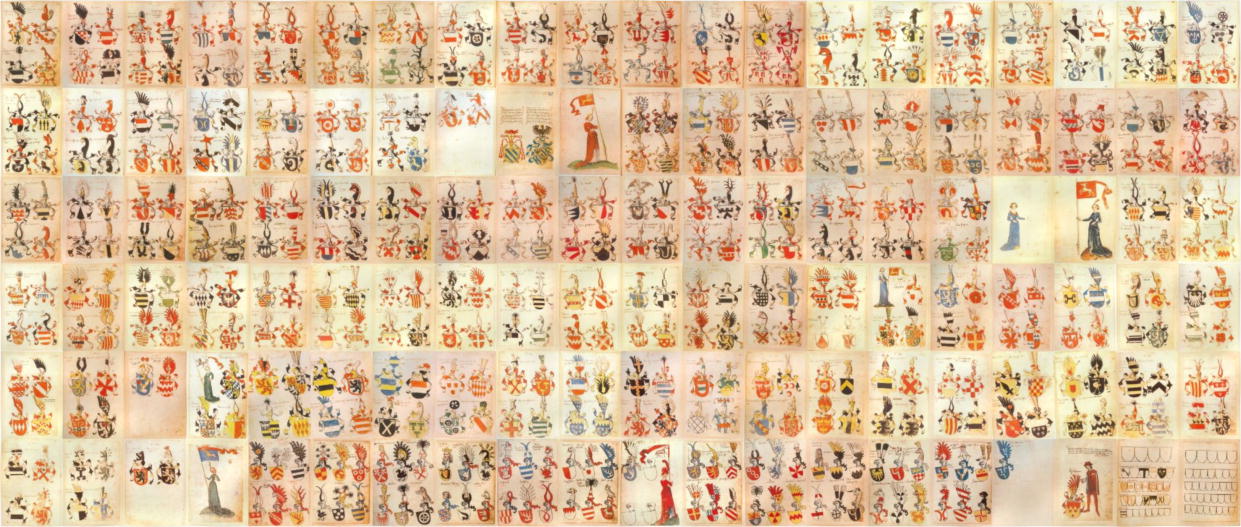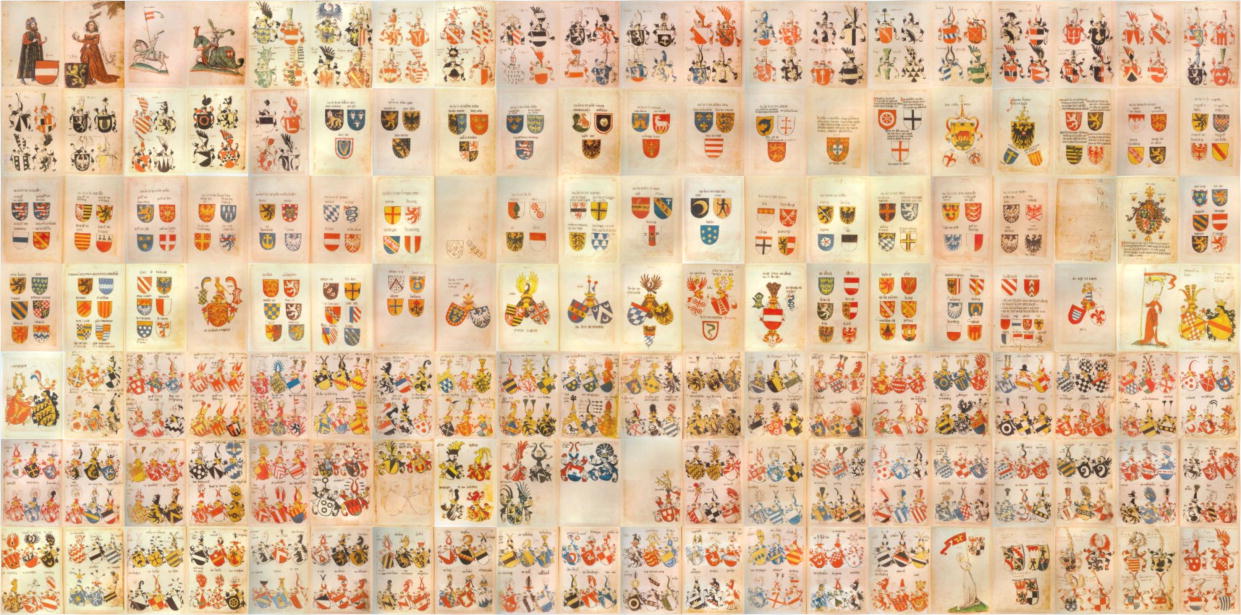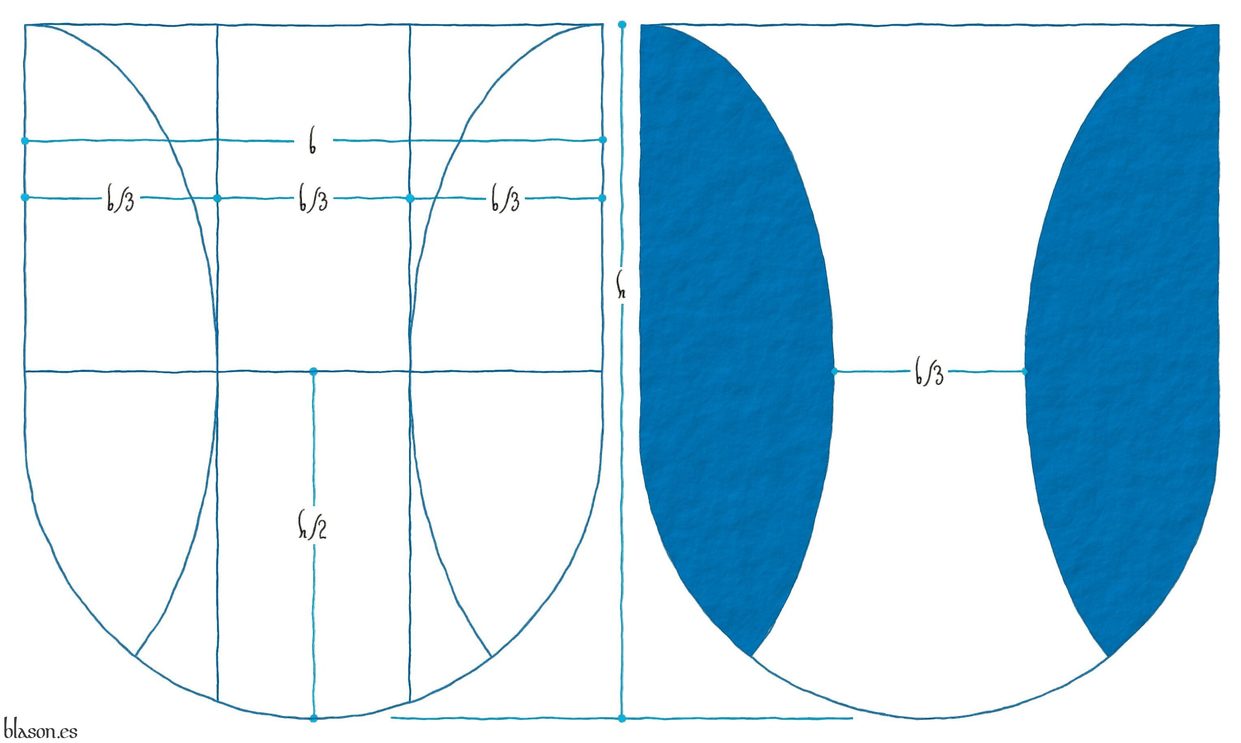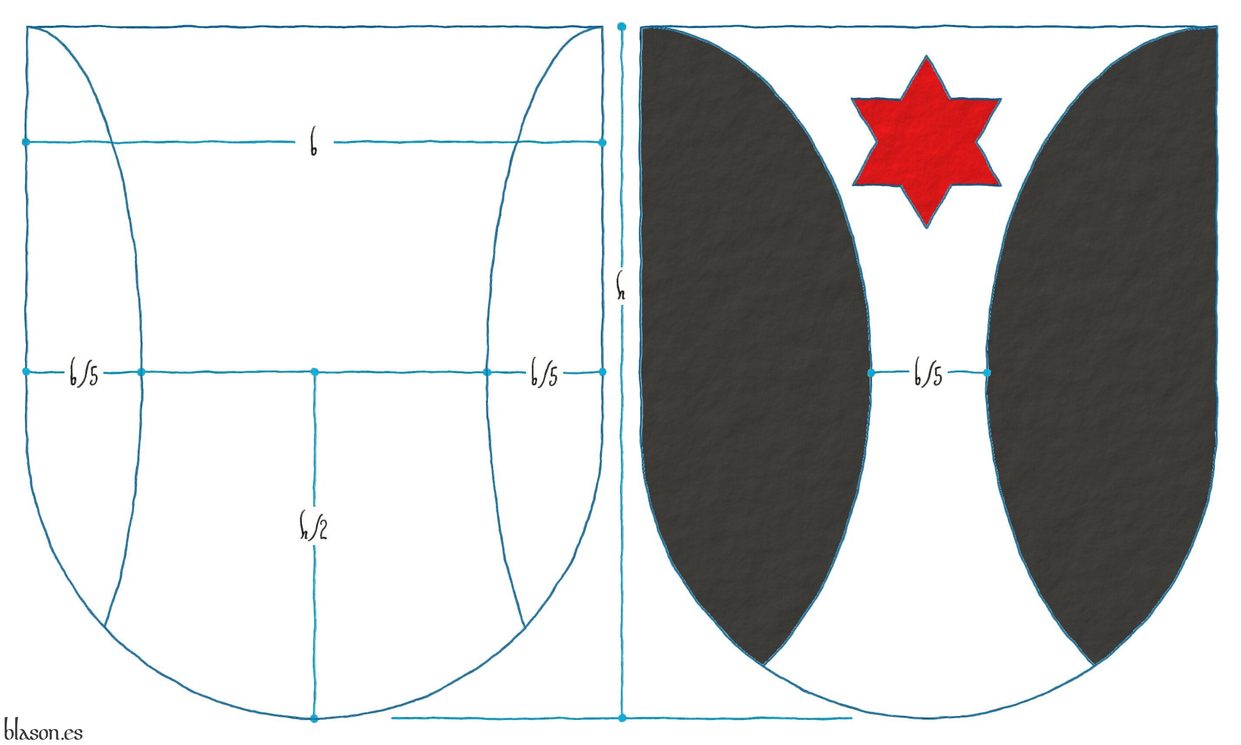
![Ver [Becher, C.; Gamber, O.; 1986] en referencias bibliográficas. Libro abierto, hojas de plata, filo de oro, guardas de gules, tapas de sable.](../css/Libro.Bibliografia.png)
Becher, C.; Gamber, O.; 1986
Charlotte Becher and Ortwin Gamber, «Die Wappenbücher Herzog Albrechts VI. von Österreich: Ingeram-Codex der ehem, Bibliothek Cotta, Volume 1», editado por Böhlau Verlag Wien, 178 pages, ISBN 3-205-05002-9 y 978-32-05050-02-5, Vienna, Cologne, Graz, 1986.
Dedicated exclusively to the study and analysis of the armorial [Ingeram, H.; 1459].
Bibliographical reference of century XX.
Classification: German language, Manuscript, Armorial roll and In color.
The 2 authors are Becher, Charlotte and Gamber, Ortwin.
The following article cites this bibliographic reference:
External resource:

![Ver [Ingeram, H.; 1459] en referencias bibliográficas. Libro abierto, hojas de plata, filo de oro, guardas de gules, tapas de sable.](../css/Libro.Bibliografia.png)
Ingeram, H.; 1459
Hans Ingeram, «Ingeram Codex», 142 pages, 1459.
The first owner of this armorial was Archduke Albert VI of Austria. Hans Ingeram included in each page of his book from 1 to 6 coats of arms, he dedicated the initial part to the Habsburg coats of arms, to imaginary coats of arms and to the coats of arms of European kingdoms, generally using 4 coats of arms per page, and dedicated the final 2/3 of its content to depicting 6 coats of arms per page of the lower German nobility, especially nobles belonging to a special type of «associations» whose purpose was the organization of tournaments. A monograph on this armorial can be consulted in [Becher, C.; Gamber, O.; 1986].
Bibliographical reference of century XV.
Classification: Manuscript and Armorial roll.
Author: Ingeram, Hans.
The following articles cite this bibliographic reference:
External links:


Edward IV of England
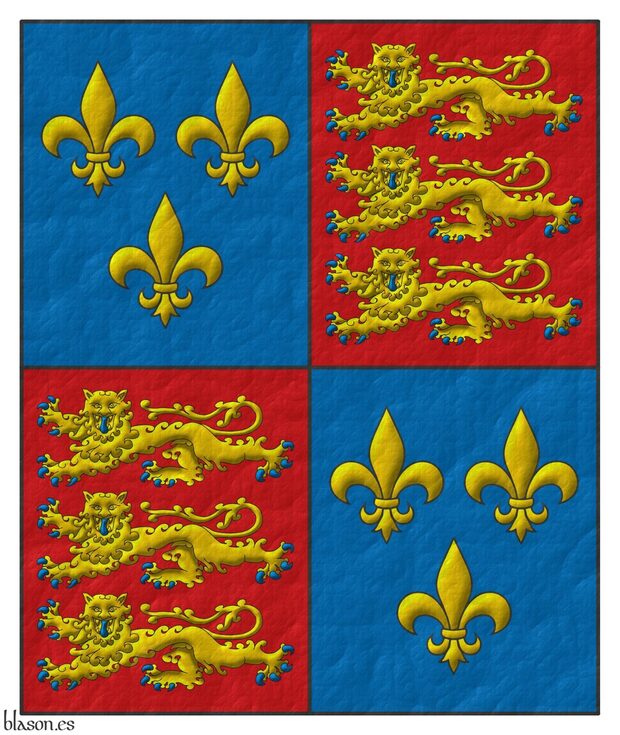
Banner Quarterly: 1 and 4 Azure, three fleurs de lis Or; 2 and 3 Gules, three lions, passant, guardant, in pale Or, armed and langued Azure.
Pendón cuartelado: 1o y 4o de azur, tres flores de lis de oro; 2o y 3o de gules, tres leopardos en palo de oro, armados y lampasados de azur.
Banner interpreted by me as follows: with the proportions of 5x6, like a shield; the field is coloured in flat tinctures Gules and Azure; the fleurs-de-lis and the leopards are outlined in Sable and illuminated in Or; and the banner’s finish resembles fabric.
Its design follows [Edward IV of England; 1461; row 27, 2nd column, final banner]:
- which represents what are considered «the royal arms of England»,
- which were also borne by Henry V of England,
- which Henry VI of England placed in the 2nd quarter of a per pale shield, where he set those of France in the 1st, and
- which were restored by Henry IV, as shown here.
Blazon keywords: Quarterly, Azure, Or, Three, Fleur de lis, Ordered, Gules, Leopard, Armed, Langued and In pale.
Style keywords: Rectangular, Illuminated, Outlined in sable and Fabric.
Classification: Interpreted, Personal, Flag, Banner of arms, Kingdom of England and House of York.
Bearer: Edward IV of England.


Edward IV, armorial for His coronation
Composition of the armorial of [Edward IV of England; 1461] based on a set of photographs sourced from the «American Branch» of «The Richard III Society». The rows of shields and banners have been numbered from row 1 to row 27.
Classification: PDF, Kingdom of England, House of York and Personal.
Bearer: Edward IV of England.


Edward IV, quartered con Castile and León
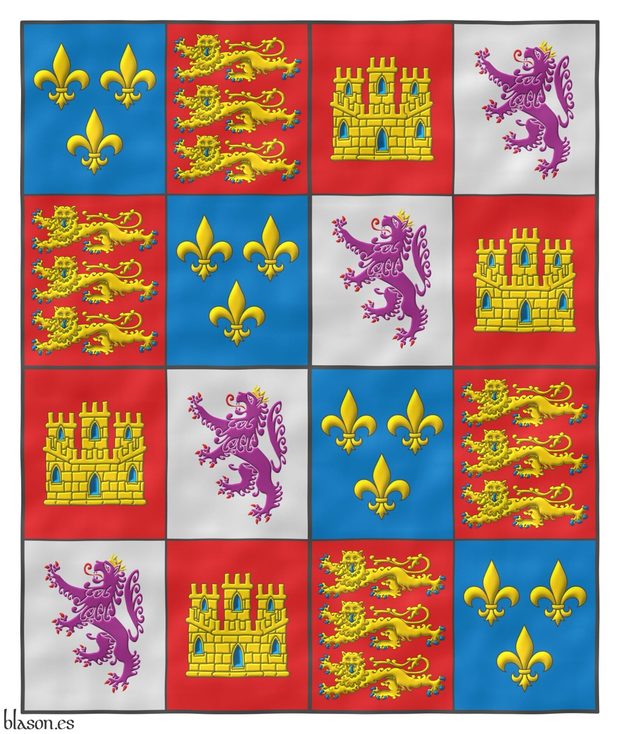
Banner quarterly of sixteen: 1, 6, 11, and 16 Azure, three fleurs de lis Or; 2, 5, 12, and 15 Gules, three lions, passant, guardant, in pale Or, armed and langued Azure; 3, 8, 9, and 14 Gules, a castle triple towered Or, port and windows Azure, masoned Sable; 4, 7, 10, and 13 Argent, a lion rampant Purpure, armed and langued Gules, crowned Or.
Pendón cuartelado de dieciseis: 1o, 6o, 11o y 16o de azur, tres flores de lis de oro; 2o, 5o, 12o y 15o de gules, tres leopardos en palo de oro, armados y lampasados de azur; 3o, 8o, 9o y 14o de gules, un castillo de oro, aclarado de azur, mazonado de sable; 4o, 7o, 10o y 13o de plata, un león rampante de púrpura, armado y lampasado de gules, coronado de oro.
Banner interpreted by me as follows: its shape preserves the 5x6 proportions of a shield; the field is enamelled with flat tinctures Gules and Azure; the castles, fleurs-de-lis, and leopards are outlined in Sable; but the lions are outlined in their field; and the finish of the banner is watercoloured.
I have interpreted it from a simplification of the banner appearing in [Edward IV of England; 1461; row 27, 1st column, final banner], which reflects Edward IV’s aspirations to the throne of Castile and León. In that armorial, this banner is held by a «White Lion of March», which was the personal badge of Edward IV.
Blazon keywords: Quarterly, Azure, Or, Three, Fleur de lis, Ordered, Gules, Leopard, Armed, Langued, In pale, Sable, One, Castle, Port and windows, Masoned, Argent, Purpure, Lion, Rampant and Crowned.
Style keywords: Rectangular, Illuminated, Outlined in sable, Outlined in the field tincture and Watercolor.
Classification: Interpreted, Personal, Flag, Banner of arms, Kingdom of England and House of York.
Bearer: Edward IV of England.


Pendón con inescutcheon de Edward IV
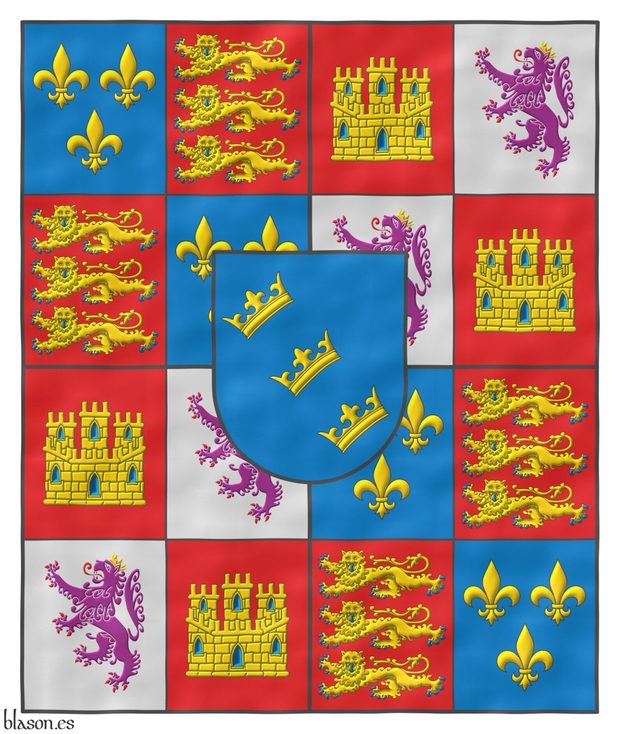
Banner quarterly of sixteen: 1, 6, 11, and 16 Azure, three fleurs de lis Or; 2, 5, 12, and 15 Gules, three lions, passant, guardant, in pale Or, armed and langued Azure; 3, 8, 9, and 14 Gules, a castle triple towered Or, port and windows Azure, masoned Sable; 4, 7, 10, and 13 Argent, a lion rampant Purpure, armed and langued Gules, crowned Or; an inescutcheon Azure, three crowns in bend, bendwise Or.
Pendón cuartelado de dieciseis: 1o, 6o, 11o y 16o de azur, tres flores de lis de oro; 2o, 5o, 12o y 15o de gules, tres leopardos en palo de oro, armados y lampasados de azur; 3o, 8o, 9o y 14o de gules, un castillo de oro, aclarado de azur, mazonado de sable; 4o, 7o, 10o y 13o de plata, un león rampante de púrpura, armado y lampasado de gules, coronado de oro; un escuson de azur, tres coronas en banda, puestas en banda de oro.
Banner interpreted as follows: with the 5x6 proportions of a shield; the field, including that of the escutcheon, is enamelled with flat tinctures Gules and Azure; the crowns, castles, fleurs-de-lis, and leopards are outlined in Sable; except the lions, which are outlined in their field; and the whole composition is watercoloured.
In the armorial [Edward IV of England; 1461; row 27, 1st column, final banner], these arms appear twice:
- At the beginning, in the equestrian portrait of Edward IV, on the caparison of his horse.
- In the final banner held by Edward IV’s personal badge, a «White Lion of March».
Blazon keywords: Quarterly, Azure, Or, Three, Fleur de lis, Ordered, Gules, Leopard, Armed, Langued, In pale, Sable, One, Castle, Port and windows, Masoned, Argent, Purpure, Lion, Rampant, Crowned, Inescutcheon, Crown, In bend and Bendwise.
Style keywords: Rectangular, Illuminated, Outlined in sable, Outlined in the field tincture and Watercolor.
Classification: Interpreted, Personal, Flag, Banner of arms, Kingdom of England and House of York.
Bearer: Edward IV of England.

![Ver [Flanched, schemaat one-third] en criterios utilizados. Unicornio saltante sobre la divisa, criterio.](../css/Unicornio.Criterio.png)
Flanched, schemaat one-third
Outlines and proportions of a flanched design at one-third.
This is my standardized way of delineating curved flanches, so that they remain tangent to a pale and, therefore, the width of both curved flanches and the space between them is equal to one third of the base. Some draw the flanches using circles, but I believe they look better as two half-ovals, which together would form a complete oval, with the height equal to that of the shield and the width two thirds of the base of the shield, that is, one third for each of the flanches, as in the figures illustrating this article. However, it should be noted that, depending on the charges, the separation distance may be adjusted.
Types of flanched designs
The «flanqueado curvo» corresponds to «flanched» in English, since for them the curved form is the default. [Avilés, J.; 1725b; page 92, figure 197] calls it «flanqueado en óvalo».
The «flanqueado apuntado» formed by 2 opposed triangles I call «pointed flanched» in English, as I have not found a better term. [Avilés, J.; 1725b; page 92, figure 198] calls it «flanqueado en sotuer», but what he draws in his book actually corresponds to a «cuartelado en sotuer» since the two points of the flanking meet at the center of the coat of arms.
«Flanqueado» without adjectives corresponds in Castilian to an «adiestrado» as opposed to a «siniestrado», and I refer to it in English as «flanked by two pales» having found no better translation.
Blazon keywords: Flanched.
Style keywords: Semi-circular.
Classification: Criterion and Schema.
Bearer: Oschoven of the Rhin.


Flanched, schemaat one-fifth
Outlines and proportions of a flanched design at one-fifth.
Regarding the flanched design, [Avilés, J.; 1725a; page 92] writes: «it is said of a figure that divides the Shield from the side of the flanks, sometimes by means of half-ovals», such as those in the diagram that illustrates this article, «and other times by means of half-lozenges, which run from the angle of the Chief to the angle of the base on the same side, whence they take their beginning».
In [Avilés, J.; 1725a; figure 197] an example of a flanched shield is illustrated with the arms of Oschoven on the Rhine, where the space left between both flanches is 1/5 of the base of the shield and, therefore, the width of each flank is 2/5 of the base of the shield, being 2/5 + 1/5 + 2/5 equal to the full base.
Blazon keywords: Flanched.
Style keywords: Semi-circular.
Classification: Schema.
Bearer: Oschoven of the Rhin.

Continue with: Oschoven of the Rhin.
-
Language
-
Categories of heraldry
-
Divisions of the field
- Without divisions
- Party per pale
- Party per fess
- Party per bend
- Party per bend sinister
- Tierce
- Tierce sinister
- Tierced per pale
- Tierced per fess
- Tierced per bend
- Tierced pallwise inverted
- Quarterly
- Quarterly per saltire
- Gyronny
- Party per fess, the chief per pale
- Party per pale, the sinister per fess
- Party per fess, the base per pale
- Party per pale, the dexter per fess
- Chapé
- Chaussé
- Embrassé
- Contre-embrassé
- Party per chevron
- Enté
- Enté en point
- Flanched
-
Metals
-
Colours
-
Furs
-
Other tinctures
-
Ordinaries and sub-ordinaries
-
Diminutives of the ordinaries
-
Geometric charges
-
Composite ordinaries
-
Inanimate charges from Nature
Atom, Crescent, Diamond, Emerald, Estoile, Increscent, Lightning flash, Moon, Mount, Mullet, Mullet of four points, Orbital, Plough of Ursa Major, Rainbow, Ray of the sun, River, Sea, Snowflake, Sun, Sun in splendour, Sun of May, Trimount, Water and Wave.
-
Vegetal charges from Nature
Acorn, Apple, Apple tree, Ash, Bluebonnet, Camellia, Chrysanthemum, Cinquefoil, Cornflower, Dogwood flower, Double rose, Elm, Fleur de lis, Flower, Gourd, Holm oak, Hop cone, Kapok tree, Laurel, Lily, Linden, Lotus flower, Madonna lily, Mexican cedar tree, Oak, Olive tree, Palm tree, Plantain plant, Pomegranate, Poplar leaf, Rose, Shamrock, Sunflower, Thistle, Tree, Tulip, Vine and Wheat.
-
Animal charges from Nature
Badger, Bald eagle, Barbel, Barn owl, Bear, Beaver, Beetle, Bighorn sheep, Blackbird, Boar, Brach hound, Bull, Doe, Dog, Dolphin, Dove, Eagle, Elephant, Falcon, Female figure, Fish, Flame, Fly, Fox, Frog, Goat, Goldfinch, Goose, Heron, Horse, Hummingbird, Jaguar, Lark, Leopard, Lion, Lion passant, Lion rampant guardant, Lioness, Lynx, Male figure, Martlet, Merino ram, Owl, Panther, Parrot, Peacock, Pelican, Pelican in her piety, Puffin, Quetzal, Raven, Roe deer, Rooster, Savage, Seagull, Serpent, She-wolf, Stag, Starling, Talbot, Tyger, Vulture, Warren hound and Wolf.
-
Parts of natural charges
Arm, Beak, Branch, Caboshed, Chest, Claw, Covert, Dorsal fin, Eagle claw, Ermine spot, Escallop, Feather, Foot (palmiped), Foreleg, Forepaw, Hand, Head, Heart, Hoof, Leaf, Neck, Ostrich feather, Palm frond, Paw, Roe deers' attires, Shoulder, Sprig, Stags' attires, Stem, Swallow-tail, Tail, Tail addorsed, Tail fin, Talon, Tooth, Trunk, Trunk (elephant), Two hands clasped, Two wings in vol, Udder, Wheat spike, Wing and Wrist.
-
Artificial charges
Ace of spades, Anchor, Anvil, Arch, Arm vambraced, Armillary sphere, Arrow, Axe, Bell, Bell tower, Beret, Bonfire, Book, Bookmark, Bow, Branding iron, Bridge, Broken, Buckle, Cannon, Cannon dismounted, Cannon port, Canopy roof, Carbuncle, Castle, Celtic Trinity knot, Chain, Chess rooks, Church, Clarion, Clay pot, Closed book, Club, Column, Comb, Compass rose, Conductor's baton, Cord, Covered cup, Crozier, Crucible, Cuffed, Cup, Cyclamor, Dagger, Double vajra, Drum, Ecclesiastical cap, Fanon, Federschwert, Fleam, Four crescents joined millsailwise, Galician granary, Garb, Gauntlet, Geometric solid, Grenade, Halberd, Hammer, Harp, Host, Hourglass, Key, Key ward, Knight, Knot, Lantern, Letter, Line, Loincloth, Menorah, Millrind, Millstone, Millwheel, Monstrance, Mortar, Mullet of six points pierced, Nail, Non-classic artifact, Norman ship, Number, Oar, Oil lamp, Open book, Page, Pair of scales, Parchment, Pestle, Piano, Pilgrim's staff, Plough share, Polish winged hussar, Port, Portcullis, Potent, Quill, Ribbon, Rosette of acanthus leaves, Sabre, Sackbut, Sail, Scroll, Scythe, Sheaf of tobacco, Ship, Skirt, Spear, Spear's head, Stairway, Star of David, Step, Sword, Symbol, Tetrahedron, Torch, Tower, Trident, Trumpet, Turret, Two-handed sword, Wagon-wheel, Water-bouget, Wheel, Winnowing fan and With a turret.
-
Immaterial charges
Angel, Archangel, Basilisk, Dragon, Dragon's head, Garuda, Golden fleece, Griffin, Heart enflamed, Justice, Mermaid, Our Lady of Mercy, Ouroboros, Paschal lamb, Pegasus, Phoenix, Sacred Heart of Jesus, Saint George, Sea-griffin, Trinity, Triton, Unicorn, Winged hand and Wyvern.
-
External elements
-
Heraldic creations
-
References
-
Formats
-
Keywords on this page
Port and windows, Watercolor, Armed, Armorial roll, Azure, Flag, Bibliography, House of York, Castle, Crown, Crowned, Criterion, Quarterly, Outlined in sable, Outlined in the field tincture, Edward IV of England, In bend, In color, In pale, Fabric, Inescutcheon, Schema, Mullet, Flanched, Fleur de lis, Personal, Gules, Illuminated, Interpreted, Chief, Langued, German language, Leopard, Lion, Manuscript, Masoned, Semi-circular, Ordered, Or, Oschoven of the Rhin, Banner of arms, Argent, Purpure, Rampant, Rectangular, Kingdom of England, Sable, Three and One.

